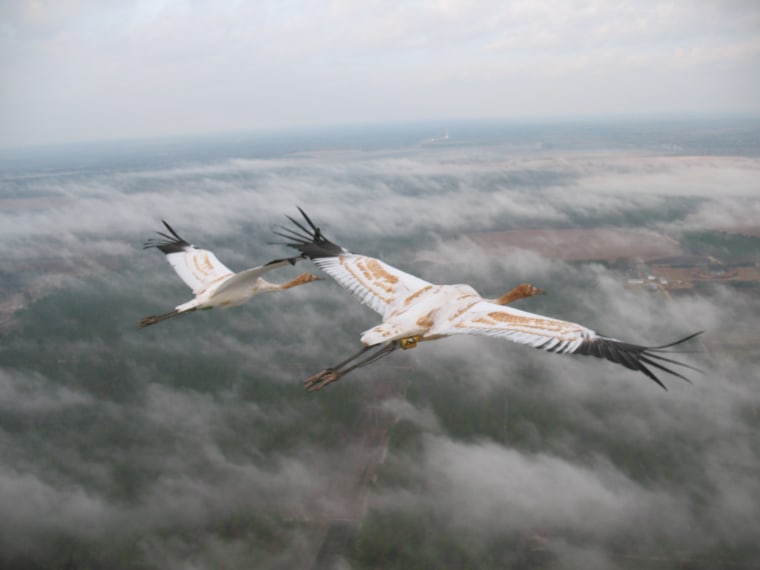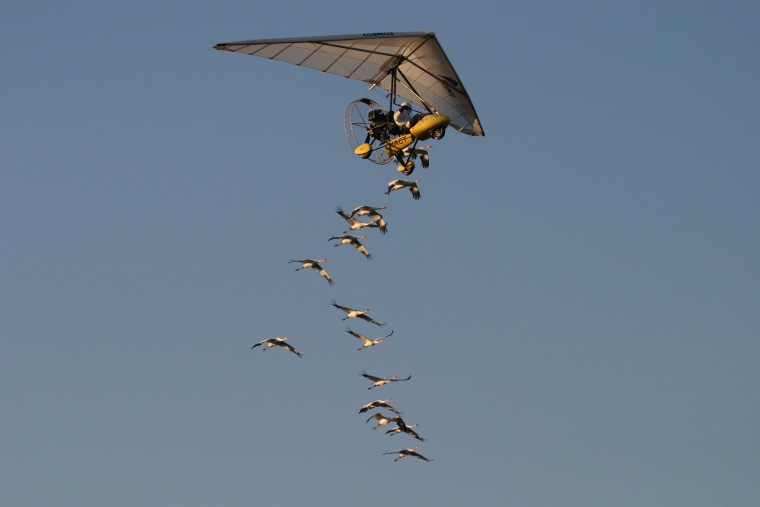When endangered whooping cranes fly their routes to summer breeding grounds, the old birds play a crucial role in showing the young birds where to go.
"This learning takes place over many years," Thomas Mueller, an expert on animal migration at the University of Maryland and lead author of a study on the cranes' migration habits, told NBC News. "It is a long-term process."
The finding adds new support for the idea that at least some of the bird's migratory behavior is learned from experience rather than all of it being the result of information encoded in genes, he noted.
The research, reported Thursday in the journal Science, takes advantage of eight years of data collected as part of a conservation effort to reintroduce endangered whooping cranes to their historic range.
The birds are bred in captivity in Maryland and then transported to Wisconsin in the summer, where they are trained to follow a human-piloted ultralight on their first southbound fall migration. After that first flight, the birds are left to their own devices, though they're carefully monitored by scientists.
Mueller and colleagues analyzed data collected after that inaugural flight. The data show that "if younger birds fly with older birds, they do better," Mueller said. "And it matters how old that older bird is."
When the oldest cranes in the group were just 1 year old, the cranes flew off course by about 47.3 miles. But when the oldest cranes were 8 years old, the birds went off course by about 29.1 miles.

Weather plays a role
Why none of the birds fly in a perfectly straight line probably has to do with the weather, Mueller noted. Most flew off course toward the east, an indication that they were being pushed that direction from the predominantly westerly winds.
Older birds may be better able to cope with the winds, or elect not to fly on particularly bad weather days, Mueller noted. Likewise, the older birds may stick to the straighter course because they are more familiar with the path.
"The more often you go a route, the better you know exactly where you are and where to go next, just based on landmarks along the way," he said, adding that these hypotheses have not been tested.
The researchers didn't find support for the idea that genetic relatedness plays a role in how straight a path the cranes take. Before the study was done, they expected that the flights of related birds might be more similar to each other than those of non-related birds. But Mueller said "we couldn't find that effect."
"It doesn't mean it doesn't exist, we just didn't see it in the data that we have," he added. "On the other hand, genetics are clearly also important for the whole process, because the first northbound migration the birds go on their own initiation without any sort of learning … that seems to be an innate program."
The culture of cranes
The research may help scientists better understand how to help these reintroduced whooping cranes successfully reproduce. That's one of the biggest challenges facing this population, noted Sarah Converse, a research ecologist and study co-author with the U.S. Geological Survey who leads the reintroduction effort.
"One of the things we're uncertain about is whether the poor reproduction we're currently seeing may improve over time due to learning by the birds," she told NBC News in an email. "For example, maybe young chicks learn from their parents how to be successful parents themselves."
The new research, she added, lends some support to this learning hypothesis, given that learning behavior appears crucial to successful migration.
"In other words, our results suggest that restoring whooping crane populations requires restoring the whooping crane culture — the knowledge that birds accumulate over time and pass directly between them," she said.
If so, she added, "it may well be important to have patience if we hope to see migratory whooping cranes thrive in eastern North America."
John Roach is a contributing writer for NBC News. To learn more about him, visit his website.
